Articles
- Page Path
- HOME > J Korean Acad Nurs > Volume 42(7); 2012 > Article
-
Original Article
- Effects of a Face-to-face Self-management Program on Knowledge, Self-care Practice and Kidney Function in Patients with Chronic Kidney Disease before the Renal Replacement Therapy
- Eun Sung Choi, Jia Lee
-
Journal of Korean Academy of Nursing 2012;42(7):1070-1078.
DOI: https://doi.org/10.4040/jkan.2012.42.7.1070
Published online: December 31, 2012
1Education Graduate School, Kyung Hee University, Seoul, Korea.
2College of Nursing Science, East-West Nursing Research Institute, Kyung Hee University, Seoul, Korea.
- Address reprint requests to: Lee, Jia. College of Nursing Science, East-West Nursing Research Institute, Kyung Hee University, 26 Kyunghee-daero, Dongdaemun-gu, Seoul 130-701, Korea. Tel: +82-2-961-0894, Fax: +82-2-961-9398, leejia@khu.ac.kr
© 2012 Korean Society of Nursing Science
- 961 Views
- 19 Download
- 33 Crossref
Abstract
-
Purpose
- The purpose of this study was to examine the effects of a face-to-face self-management educational program on knowledge, self-care practice and kidney function in patients with chronic kidney disease (CKD) before kidney replacement therapy.
-
Methods
- This study employed a nonequivalent control group, non-synchronized design. Data were collected from 61 patients with CKD visiting an outpatient department of nephrology in a university hospital in Seoul, South Korea. The experimental group (n=31) took the pre-test, then after 3 weeks, face-to-face education and individualized consultation (1st intervention), after a week of self-practice, the 1st post-test, followed by re-enforcement education and consultation (2nd intervention), and 4 weeks later, the 2nd post-test. The control group (n=30) took the pre-test and post-tests at 4 and 8 weeks.
-
Results
- Scores for knowledge of CKD and self-care practice over time improved significantly in the experimental group compared to the control group. Kidney function did not improve significantly in the experimental group.
-
Conclusion
- Health care providers can identify various and individualized needs, and provide effective education and consultation through face to face self-management for patients with chronic irreversible illnesses. Nurses can coordinate for these program by designing and providing systematic and effective education.
INTRODUCTION
METHODS
1) Knowledge of chronic kidney disease scale
2) Self-care practice scale for CKD patients
3) Physiological indicators of kidney function
(1) Blood Urea Nitrogen (BUN)/Creatinine
(2) Sodium/Potassium (Na/K)
(3) Calcium/Phosphate (Ca/P)
(4) Hemoglobin (Hb)
(5) Glomerular Filtration Rate (GFR)
4) Demographic characteristics
RESULTS
DISCUSSION
CONCLUSION
- 1. Bae JY, Park HJ, Kim SS, Bang JS. Factors influencing depression in patients with chronic renal failure. J Korean Acad Psychiatr Ment Health Nurs. 2011;20(3):261–270.Article
- 2. Chae DW, Lee JH, Kim YK, Um JH, Kim GH, Yang WS, et al. Primer on kidney diseases. 2002;Seoul, Shin-Heong Medscience.
- 3. Faul F, Erdfelder E, Buchner A, Lang AG. Statistical power analyses using G*Power 3.1: Tests for correlation and regression analyses. Behav Res Methods. 2009;41:1149–1160. http://dx.doi.org/10.3758/BRM.41.4.1149.ArticlePubMedPDF
- 4. Health Insurance Review & Assessment Service. Increase of 37.1% in patients with chronic renal failure for the last 5 years. 2011;03 18 Retrieved September 1, 2011. from http://www.hira.or.kr/dummy.do?pgmid=HIRAA020041000000&cmsurl=/cms/notice/02/1204393_13390.html.
- 5. Ishani A, Grandits GA, Grimm RH, Svendsen KH, Collins AJ, Prineas RJ, et al. Association of single measurements of dipstick proteinuria, estimated glomerular filtration rate, and hematocrit with 25-year incidence of end-stage renal disease in the multiple risk factor intervention trial. J Am Soc Nephrol. 2006;17:1444–1452. http://dx.doi.org/10.1681/ASN.2005091012.ArticlePubMed
- 6. Jang YH, Oh HS, Jang KS. Self-care behaviors and physiological index according to cognitive function of hemodialysis patients. Korean J Health Serv Manag. 2012;6(2):57–69.Article
- 7. Jung MY. Development of web-based educational program for peritoneal dialysis patients. 2008;Seoul, Ewha Womans University. Unpublished master's thesis.
- 8. Kim AY. The effect of education program on early hemodialysis patients' knowledge, self-care practice and physiologic index. 2012;Gwangju, Chonnam National University. Unpublished master's thesis.
- 9. Kim HW, Choi S. Study on knowledge levels of pre-dialysis, chronic renal failure patients at glomerular filtration rates and their educational demands. J Korean Biol Nurs Sci. 2010;12:63–72.
- 10. Kim EJ, Chung CH, Park MY, Choi SJ, Kim JK, Hwang SD. Mortality predictors in patients treated with continuous renal replacement. Korean J Nephrol. 2011;30:73–79.
- 11. Kim AY, Kim SJ. The effect of education program on early hemodialysis patients' knowledge, self-care practice and physiologic index. Chonnam J Nurs Sci. 2008;13(1):95–109.
- 12. Klahr S. The modification of diet in renal disease study. N Engl J Med. 1989;320:864–866. http://dx.doi.org/10.1056/NEJM198903303201310.ArticlePubMed
- 13. Lee SJ, Park HS, Han JH, Kim HJ, Seo MW, Choi EA, et al. Effects of an individualized educational program on knowledge, compliance on physiologic parameters in non-compliant hemodialysis patients. J Korean Clin Nurs Res. 2009;15(3):5–16.
- 14. Lee TW. Kidney disease. 2007;Seoul, Hong-Shin Publication.
- 15. Park HM, Lee HS. Effects of empowerment education program for hemodialysis patients on self-efficacy, self-care agency, self-care activities and physiologic parameters. Korean J Rehabil Nurs. 2010;13:151–160.
- 16. Reddy V, Symes F, Sethi N, Scally AJ, Scott J, Mumtaz R, et al. Dietitian-led education program to improve phosphate control in a single-center hemodialysis population. J Ren Nutr. 2009;19:314–320. http://dx.doi.org/10.1053/j.jrn.2008.11.001.ArticlePubMed
- 17. Rioux JP, Cheema H, Bargman JM, Watson D, Chan CT. Effect of an in-hospital chronic kidney disease education program among patients with unplanned urgent-start dialysis. Clin J Am Soc Nephrol. 2011;6:799–804. http://dx.doi.org/10.2215/CJN.07090810.ArticlePubMedPMC
- 18. Song MR. The development and test of self-efficacy promotion program on self-care of hemodialysis patients. 1999;Seoul, Seoul National University. Unpublished doctoral dissertation.
- 19. Szromba C, Thies MA, Ossman SS. Advancing chronic kidney disease care: New imperatives for recognition and intervention. Nephrol Nurs J. 2002;29:547–559.PubMed
- 20. The Korean Society of Nephrology. Chronic kidney disease. 2006;12 01 Retrieved September 1, 2011. from http://www.ksn.or.kr/kidney/qna.php?code=qna&category=01&number=20.
- 21. The Korean Society of Nephrology. Renal replacement therapy. 2010;12 31 Retrieved September 1, 2011. from http://www.ksn.or.kr/kidney/?code=qna.
- 22. Yen M, Huang JJ, Teng HL. Education for patients with chronic kidney disease in Taiwan: A prospective repeated measures study. J Clin Nurs. 2008;17:2927–2934. http://dx.doi.org/10.1111/j.1365-2702.2008.02348.x.ArticlePubMed
REFERENCES
Figure & Data
REFERENCES
Citations

- The impact of a partnership care model on self-efficacy and self-care in hemodialysis patients: A quasi-experimental study
Khodayar Oshvandi, Hossein Moradi, Salman Khazaei, Azim Azizi
Contemporary Clinical Trials Communications.2025; 44: 101459. CrossRef - Developing a Tailored eHealth Self-Management Intervention for Patients With Chronic Kidney Disease in China: Intervention Mapping Approach
Hongxia Shen, Rianne van der Kleij, Paul J M van der Boog, Niels H Chavannes
JMIR Formative Research.2024; 8: e48605. CrossRef - Knowledge, attitude, practice, needs, and implementation status of intensive care unit staff toward continuous renal replacement therapy: a survey of 66 hospitals in central and South China
Xiaoyan Yu, Lin Ouyang, Jinxiu Li, Ying Peng, Dingming Zhong, Huan Yang, Yanyan Zhou
BMC Nursing.2024;[Epub] CrossRef - A comparison of the effects of patient-centered and family-centered education on treatment adherence in kidney transplant patients: a quasi-experimental study
Yarmohammadi A, khaleghparast Sh, Shabani F, Bakhshandeh H
Journal of Torbat Heydariyeh University of Medical Sciences.2024; 12(3): 1. CrossRef - The effect of a training program on the self‐care efficacy of hemodialysis patients with mineral and bone disorders: A quasi‐experimental study
Sedigheh Tashakor, Behnaz Bagherian, Zahra Salmanpour, Roghayeh Mehdipour‐Rabori
Health Science Reports.2023;[Epub] CrossRef - Effect of Health Literacy Intervention on Glycemic Control and Renal Function Among Thai Older Adults at Risk of Type 2 Diabetes Mellitus
Katekaew Seangpraw, Parichat Ong-Artborirak, Sorawit Boonyathee, Sasivimol Bootsikeaw, Supakan Kantow, Pitakpong Panta, Prakaipetch Winaiprasert
Clinical Interventions in Aging.2023; Volume 18: 1465. CrossRef - Reducing salt intake: a systematic review and meta-analysis of behavior change interventions in adults
Saman Khalesi, Edwina Williams, Christopher Irwin, David W Johnson, Jacqui Webster, Danielle McCartney, Arash Jamshidi, Corneel Vandelanotte
Nutrition Reviews.2022; 80(4): 723. CrossRef - Authentic Conversations about Self-Care with Fourth-Year Veterinary Medical Students
Adryanna S. Drake, McArthur Hafen, Elizabeth G. Davis, Bonnie R. Rush
Journal of Veterinary Medical Education.2022; 49(6): 679. CrossRef - Interventions for improving health literacy in people with chronic kidney disease
Zoe C Campbell, Jessica K Dawson, Suzanne M Kirkendall, Kirsten J McCaffery, Jesse Jansen, Katrina L Campbell, Vincent WS Lee, Angela C Webster
Cochrane Database of Systematic Reviews.2022;[Epub] CrossRef - The ABCs of Kidney Disease: Knowledge Retention and Healthcare Involvement
Daphne H. Knicely, Kristina Rinaldi, Shani Snow, Carmen Elena Cervantes, Michael J. Choi, Bernard G. Jaar, Sumeska Thavarajah
Journal of Patient Experience.2021;[Epub] CrossRef - Effectiveness of a self‐management program in enhancing quality of life, self‐care, and self‐efficacy in patients with hemodialysis: A quasi‐experimental design
Mei‐Chen Lee, Shu‐Fang Vivienne Wu, Kuo‐Cheng Lu, Chieh‐Yu Liu, Shu‐Yuan Liang, Yeu‐Hui Chuang
Seminars in Dialysis.2021; 34(4): 292. CrossRef - Patients’ and healthcare professionals’ beliefs, perceptions and needs towards chronic kidney disease self-management in China: a qualitative study
Hongxia Shen, Rianne M J J van der Kleij, Paul J M van der Boog, Wenjiao Wang, Xiaoyue Song, Zhengyan Li, Xiaoping Lou, Niels Chavannes
BMJ Open.2021; 11(3): e044059. CrossRef - Effect of patient‐centred self‐management programme on mental health, self‐efficacy and self‐management of patients with hypertensive nephropathy: A randomised controlled trial
Mei‐Chen Lee, Shu‐Fang Vivienne Wu, Kuo‐Cheng Lu, Wen‐Hug Wang, Yen‐Yen Chen, Hui‐Mei Chen
Journal of Clinical Nursing.2021; 30(21-22): 3205. CrossRef - Estudio de la competencia para el autocuidado de las personas en tratamiento renal sustitutivo con diálisis
Claudia Patricia Cantillo-Medina, Brigitte Vanessa Castro-Morea, Yury Hasbleydi Mosquera
Enfermería Nefrológica.2021; 24(4): 398. CrossRef - The effect of a self‐management program on renal function control in patients with hemodialysis in Taiwan: A longitudinal randomized controlled trial
Mei‐Chen Lee, Shu‐Fang V. Wu, Kuo‐Cheng Lu, Chief‐Yu Liu, Wen‐I Liu, Ju‐Han Liu
Japan Journal of Nursing Science.2020;[Epub] CrossRef - The effects of self‐performance management video program on patients receiving hemodialysis
Hyeyoung Cho, Sunghee Park
Japan Journal of Nursing Science.2020;[Epub] CrossRef - Effect of Internal Knowledge Sourcing on MNEs Subsidiaries’ Service Innovation Performance. The Role of Exploitative Learning and Entrepreneurial Orientation
Charles Oduro Acheampong Otoo, Wenyuan Li, Wisdom Wise Kwabla Pomegbe, Bylon Abeeku Bamfo, Courage Simon Kofi Dogbe
Journal of Information & Knowledge Management.2020; 19(04): 2050035. CrossRef - Effectiveness of pharmacist intervention model for chronic kidney disease patients; a prospective comparative study
Aisha Khokhar, Yusra Habib Khan, Tauqeer Hussain Mallhi, Humaira Majeed Khan, Nasser Hadal Alotaibi, Abdulaziz Ibrahim Alzarea, Nida Bokharee
International Journal of Clinical Pharmacy.2020; 42(2): 625. CrossRef - Patient-Centered Self-Management in Patients with Chronic Kidney Disease: Challenges and Implications
Chiu-Chu Lin, Shang-Jyh Hwang
International Journal of Environmental Research and Public Health.2020; 17(24): 9443. CrossRef - Self‐care management importance in kidney illness: a comprehensive and systematic literature review
Yalong Wu, Ling Tang, Gangqiu Li, Hao Zhang, Zhihui Jiang, Saghar Samimi Sedeh
Network Modeling Analysis in Health Informatics and Bioinformatics.2020;[Epub] CrossRef - The Effects of Self-Management Interventions on the Health Outcomes of Individuals With Chronic Kidney Disease After Critical Illness: An Integrative Review
Claudia Leung Ho Yau, Janita Chau Pak Chun
Connect: The World of Critical Care Nursing.2019;[Epub] CrossRef - Comparing Health Condition Between Wanted and Unwanted Pregnancy of Women in Hamadan City
Fatemeh Shobeiri, Parastoo Ahang Poor, Parisa Parsa, Saeid Yazdi-Ravandi
Avicenna Journal of Nursing and Midwifery Care.2019; 27(2): 82. CrossRef - Self-management interventions for adults with chronic kidney disease: a scoping review
Maoliosa Donald, Bhavneet Kaur Kahlon, Heather Beanlands, Sharon Straus, Paul Ronksley, Gwen Herrington, Allison Tong, Allan Grill, Blair Waldvogel, Chantel A Large, Claire L Large, Lori Harwood, Marta Novak, Matthew T James, Meghan Elliott, Nicolas Ferna
BMJ Open.2018; 8(3): e019814. CrossRef - A realist review: what do nurse‐led self‐management interventions achieve for outpatients with a chronic condition?
Susanne M. van Hooft, Janet M.J. Been‐Dahmen, Erwin Ista, AnneLoes van Staa, Hennie R. Boeije
Journal of Advanced Nursing.2017; 73(6): 1255. CrossRef - Effectiveness of an educational intervention (the Encourage Autonomous Self-Enrichment Program) in patients with chronic kidney disease: A randomized controlled trial
Hiroko Joboshi, Michiyo Oka
International Journal of Nursing Studies.2017; 67: 51. CrossRef - Person-centred care in chronic kidney disease: a cross-sectional study of patients’ desires for self-management support
Kathryn Havas, Clint Douglas, Ann Bonner
BMC Nephrology.2017;[Epub] CrossRef - Self-management of dietary intake using mindful eating to improve dietary intake for individuals with early stage chronic kidney disease
Gayle M. Timmerman, Muna J. Tahir, Richard M. Lewis, Deborah Samoson, Holli Temple, Michele R. Forman
Journal of Behavioral Medicine.2017; 40(5): 702. CrossRef - Self-Management Programs on eGFR, Depression, and Quality of Life among Patients with Chronic Kidney Disease: A Meta-Analysis
Mei-Chen Lee, Shu-Fang Vivienne Wu, Nan-Chen Hsieh, Juin-Ming Tsai
Asian Nursing Research.2016; 10(4): 255. CrossRef - Educational Interventions for Patients With CKD: A Systematic Review
Pamela A. Lopez-Vargas, Allison Tong, Martin Howell, Jonathan C. Craig
American Journal of Kidney Diseases.2016; 68(3): 353. CrossRef - Fragmented care and whole-person illness: Decision-making for people with chronic end-stage kidney disease
Dawn Allen, Valerie Badro, Laurie Denyer-Willis, Mary Ellen Macdonald, Anthony Paré, Tom Hutchinson, Paul Barré, Roch Beauchemin, Helen Bocti, Alison Broadbent, S Robin Cohen
Chronic Illness.2015; 11(1): 44. CrossRef - Self-Management in Chronic Disease: Clear Benefits for Blood Pressure Control in CKD
Timothy W.R. Doulton, Christopher K.T. Farmer, Paul E. Stevens
American Journal of Kidney Diseases.2015; 66(1): 12. CrossRef - Self-Management Interventions in Stages 1 to 4 Chronic Kidney Disease
Janet L. Welch, Michelle Johnson, Lani Zimmerman, Cynthia L. Russell, Susan M. Perkins, Brian S. Decker
Western Journal of Nursing Research.2015; 37(5): 652. CrossRef - SELF‐MANAGEMENT PROGRAMMES IN STAGES 1–4 CHRONIC KIDNEY DISEASE: A LITERATURE REVIEW
Ann Bonner, Kathryn Havas, Clint Douglas, Thiwawan Thepha, Paul Bennett, Robyn Clark
Journal of Renal Care.2014; 40(3): 194. CrossRef
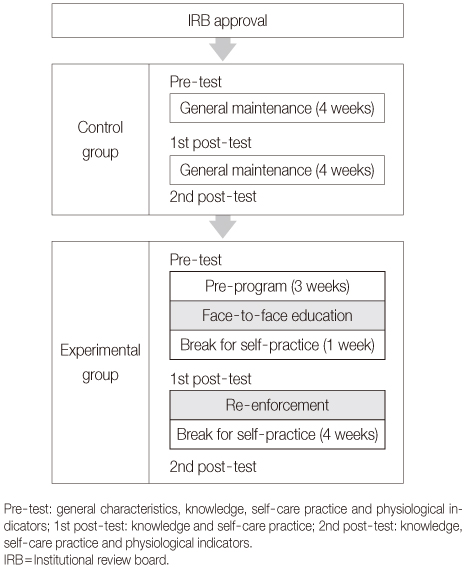
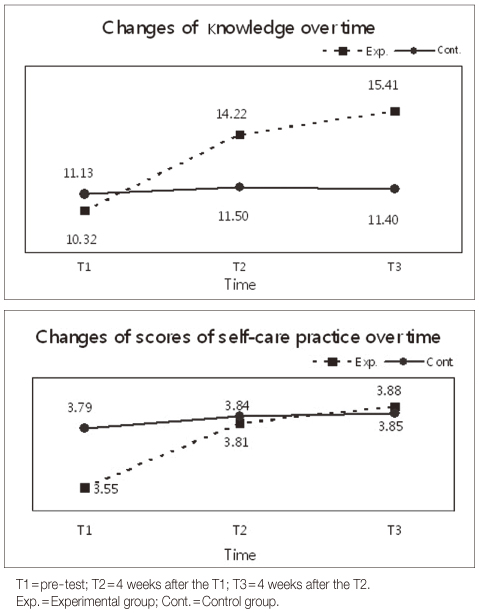
Figure 1
Figure 2
Process of the Face-to-face Self-management Program
Q&A=Question and answer.
Homogeneity Test between Experimental and Control Groups (N=61)
Exp.=Experimental group Cont.=Control group; BUN=Blood urea nitrogen; GFR=Glomerular filtration rate.
Changes in Knowledge and Self-care Practice over Time (N=61)
Exp.=Experimental group; Cont.=Control group.
Differences in Physiological Indicators between Groups (N=61)
Exp.=Experimental group; Cont.=Control group; BUN=Blood urea nitrogen; Cr=Creatinine; Hb=Hemoglobin; GFR=Glomerular filtration rate.
Q&A=Question and answer.
Exp.=Experimental group Cont.=Control group; BUN=Blood urea nitrogen; GFR=Glomerular filtration rate.
Exp.=Experimental group; Cont.=Control group.
Exp.=Experimental group; Cont.=Control group; BUN=Blood urea nitrogen; Cr=Creatinine; Hb=Hemoglobin; GFR=Glomerular filtration rate.
 KSNS
KSNS
 E-SUBMISSION
E-SUBMISSION


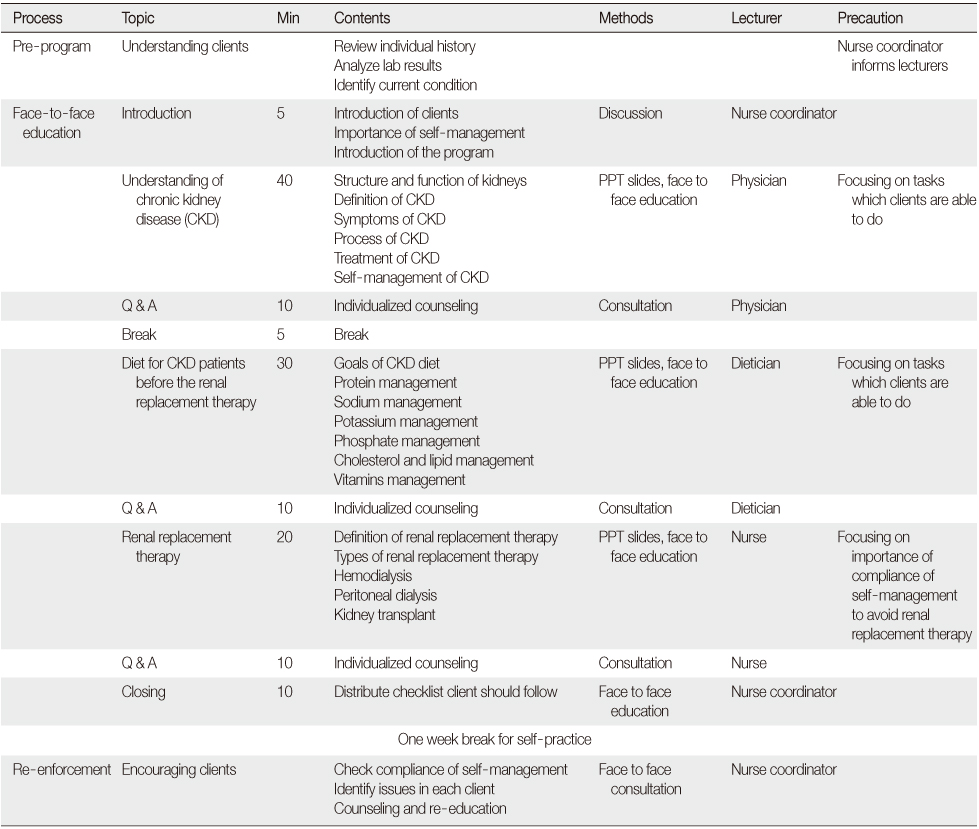
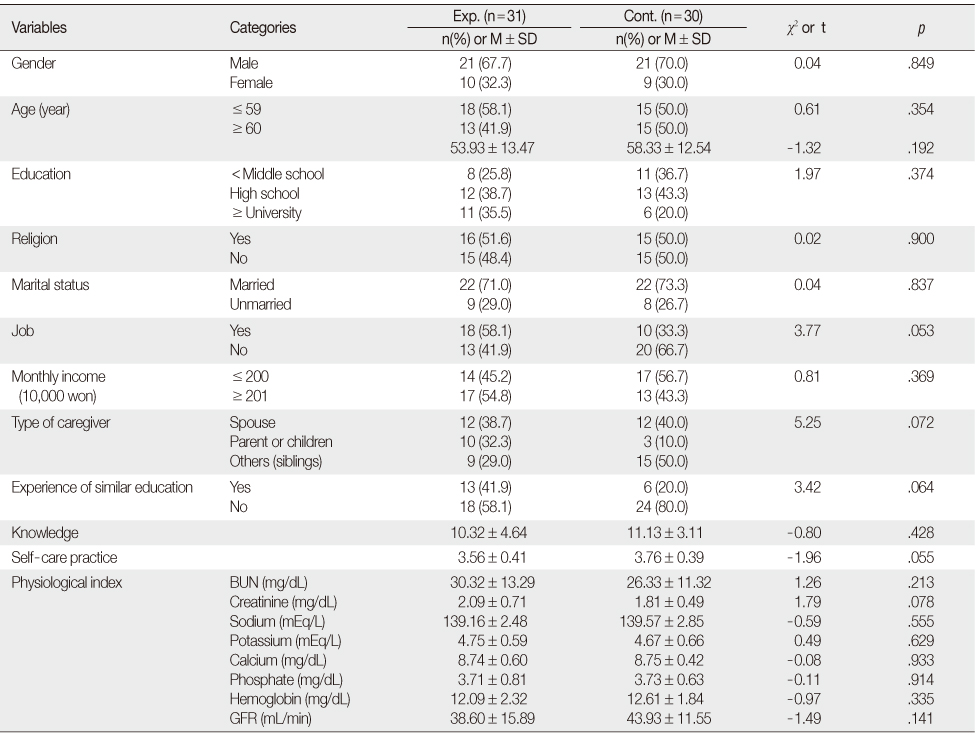

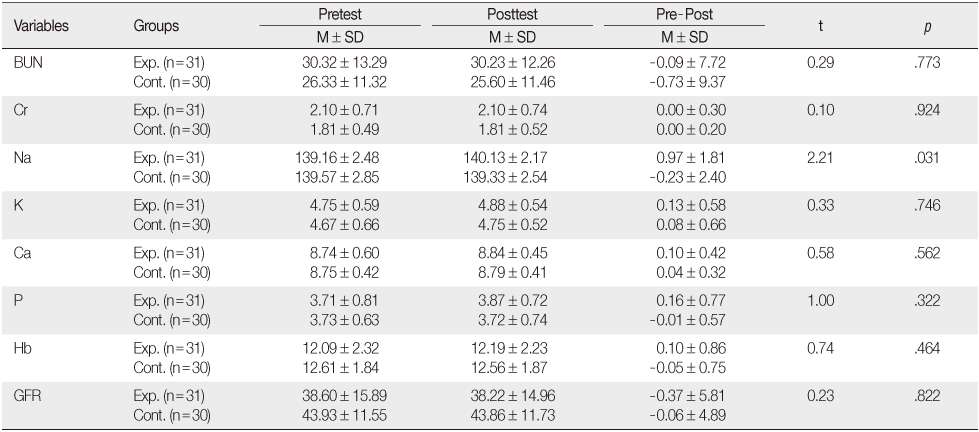
 Cite
Cite

